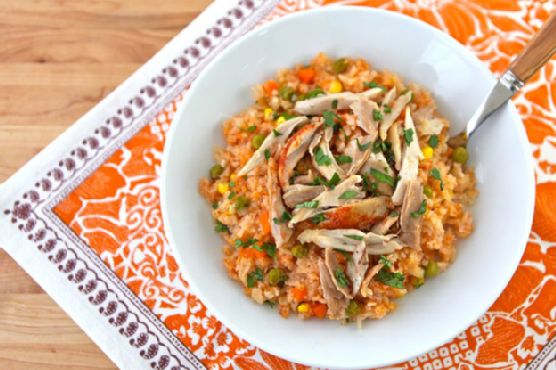Arroz con Pollo
Arroz con Pollo is a gluten free and dairy free side dish. This recipe serves 6. One portion of this dish contains about 7g of protein, 6g of fat, and a total of 316 calories. For $1.12 per serving, this recipe covers 13% of your daily requirements of vitamins and minerals. 35 people were impressed by this recipe. This recipe from Tori Avey requires carrots, roma tomatoes, mesh colanders, and onion. From preparation to the plate, this recipe takes around 1 hour and 30 minutes. All things considered, we decided this recipe deserves a spoonacular score of 71%. This score is pretty good. Similar recipes include Arroz con Pollo, Arroz con Pollo, and Arroz Con Pollo.
Servings: 6
Preparation duration: 15 minutes
Cooking duration: 75 minutes
Ingredients:
1/2 cup diced carrots
6 pieces chicken - legs and/or thighs
1/2 tsp chili powder (mild)
1/2 cup corn (fresh or frozen)
1/2 cup peas (fresh or frozen - not canned)
1 garlic clove
1/2 medium onion, peeled
1 1/2 lbs roma tomatoes, halved
Salt
2 tbsp vegetable oil (we used grapeseed)
2 cups white rice
2 mesh colanders, blender, 5 quart nonstick pot (or larger), large bowl
Equipment:
colander
blender
sieve
bowl
pot
Cooking instruction summary:
Rinse the rice well in a mesh colander, then shake to drain. Let the rice continue draining over the sink while you blend together the cooking liquid.In a blender, combine the roma tomatoes, garlic, onion, and 1 1/2 cups of water.Blend till the mixture is smooth. Pour the tomato mixture through another mesh colander or sieve into a large bowl, pushing the solids to extract as much flavored juice as possible. Reserve the juice and discard the solids.Heat up 2 tbsp of oil in a nonstick pot over medium high heat. Add the rice to the pot. Saute the rice, stirring almost constantly, for 10-15 minutes till the grains of rice start to turn golden. Be careful-- when they begin to turn golden, they can easily go to brown/burned if you don't watch them carefully.Measure the reserved tomato liquid into the pot by cupfuls. You will need 6 cups of liquid total. First measure the tomato liquid and pour into the pot (there will be about 3 cups). Once you know how much tomato liquid there is, you can measure out the remaining amount of liquid needed-- in our case, we needed 3 more cups. Add that amount of water to the pot to make 6 cups of liquid total.Stir in the diced carrots, corn, and peas along with 1 tsp of salt.Sprinkle the chicken pieces with salt (skip salting the chicken if you're using kosher meat) and chili powder. You can use up to six pieces of chicken in one pot. We took the skin off of our chicken before cooking to make the dish a bit lighter. You can leave the skin on if you prefer, which will add more flavor to the dish.Place the chicken pieces on top of the rice and vegetables, covered in the tomato liquid. Bring the mixture to a slow boil.Reduce heat to a slow, even simmer over medium low heat and cover the pot. Let the mixture simmer for 1 hour till all the liquid is absorbed and the rice is tender. Check at 30 minutes to see if the pot looks too dry. Add additional liquid as needed, and additional salt to taste, if desired. We ended up adding another 1 cup of water to the pot after 30 minutes-- the liquid absorbs pretty quickly into the rice. Check the rice again for dryness at 45 minutes. When all of the liquid has absorbed and the rice, vegetables, and chicken are tender, remove from heat. Serve the chicken over the rice, garnished with chopped cilantro if desired. I decided to debone the chicken and cut it into pieces before serving for a prettier presentation. You can serve it on the bone if you like. The rice will be quite soft-- this is the correct texture for this dish. It all comes together in a very warm, cozy, filling one-pot meal. It's simple, homey, healthy Mexican comfort food.
Step by step:
1. Rinse the rice well in a mesh colander, then shake to drain.
2. Let the rice continue draining over the sink while you blend together the cooking liquid.In a blender, combine the roma tomatoes, garlic, onion, and 1 1/2 cups of water.Blend till the mixture is smooth.
3. Pour the tomato mixture through another mesh colander or sieve into a large bowl, pushing the solids to extract as much flavored juice as possible. Reserve the juice and discard the solids.
4. Heat up 2 tbsp of oil in a nonstick pot over medium high heat.
5. Add the rice to the pot.
6. Saute the rice, stirring almost constantly, for 10-15 minutes till the grains of rice start to turn golden. Be careful-- when they begin to turn golden, they can easily go to brown/burned if you don't watch them carefully.Measure the reserved tomato liquid into the pot by cupfuls. You will need 6 cups of liquid total. First measure the tomato liquid and pour into the pot (there will be about 3 cups). Once you know how much tomato liquid there is, you can measure out the remaining amount of liquid needed-- in our case, we needed 3 more cups.
7. Add that amount of water to the pot to make 6 cups of liquid total.Stir in the diced carrots, corn, and peas along with 1 tsp of salt.Sprinkle the chicken pieces with salt (skip salting the chicken if you're using kosher meat) and chili powder. You can use up to six pieces of chicken in one pot. We took the skin off of our chicken before cooking to make the dish a bit lighter. You can leave the skin on if you prefer, which will add more flavor to the dish.
8. Place the chicken pieces on top of the rice and vegetables, covered in the tomato liquid. Bring the mixture to a slow boil.Reduce heat to a slow, even simmer over medium low heat and cover the pot.
9. Let the mixture simmer for 1 hour till all the liquid is absorbed and the rice is tender. Check at 30 minutes to see if the pot looks too dry.
10. Add additional liquid as needed, and additional salt to taste, if desired. We ended up adding another 1 cup of water to the pot after 30 minutes-- the liquid absorbs pretty quickly into the rice. Check the rice again for dryness at 45 minutes. When all of the liquid has absorbed and the rice, vegetables, and chicken are tender, remove from heat.
11. Serve the chicken over the rice, garnished with chopped cilantro if desired. I decided to debone the chicken and cut it into pieces before serving for a prettier presentation. You can serve it on the bone if you like. The rice will be quite soft-- this is the correct texture for this dish. It all comes together in a very warm, cozy, filling one-pot meal. It's simple, homey, healthy Mexican comfort food.
Nutrition Information:
covered percent of daily need
Related Videos:
Arroz con Pollo - Episode 97
Perfect Fluffy Arroz con Pollo (not sticky)
Mexican Chicken Rice Recipe | How To Make Mexican Rice | Arroz Con Pollo | One Pot Meal By Tarika















